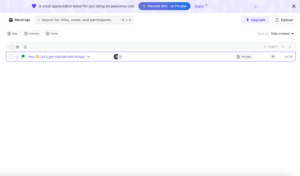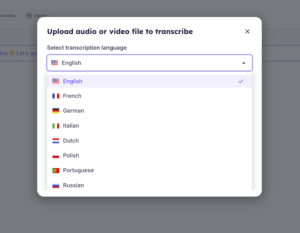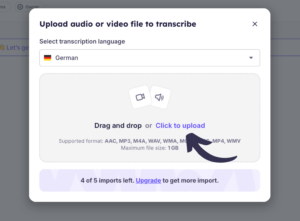Life before and after the ability to transcribe recordings has been noticeably different. This capability has transformed many areas of our lives, including work, academics, research, and more. Accurate transcription has become highly sought after, as it makes content accessible and easier to analyze. In this article, we’ll explore the best ways to transcribe your recordings, with a focus on Krisp’s game-changing feature—Import and Transcribe.
With Krisp, you can import audio or video files directly into your account for transcription. This feature works in tandem with Krisp’s AI meeting assistant, allowing you to transcribe live meetings and generate summaries afterward. Users can upload one audio or video file at a time for transcription, making it a convenient and efficient solution for creating accurate transcripts.
Why Transcribe a Recording?
If you’re unsure about whether to transcribe a recording, let’s explore the benefits it can offer.
Improved Accessibility: Sometimes, listening to recordings isn’t possible. For instance, you might watch videos with subtitles because you forgot your headphones or simply prefer reading to listening. Many people absorb information better through reading than audio, and for individuals who are deaf, transcription is essential. For these and many other reasons, transcription is a game-changer.
Enhanced Comprehension and Note-Taking: While listening may seem straightforward, it can be challenging when you need to take notes or fully grasp complex information. Stopping and replaying the recording can be distracting. Reading a text and taking notes, however, allows for a deeper understanding and a more organized approach to information retention.
Searchable Content: If you want your content to be accessible and searchable, having it in text form is crucial. Adding keywords also makes it more SEO-friendly, helping others find it online.
For these reasons and more, transcription is invaluable. Finding efficient ways to transcribe your recordings is a smart step toward making your content more accessible and engaging for a wider audience.
Manual Transcription: The Traditional Method
There are several ways to transcribe a recording, and one of the oldest methods is manual transcription, often referred to as the traditional or classic approach. This method is ideal for those who prefer to have full control over the transcription process or for those who want to ensure maximum accuracy by doing it themselves. While manual transcription allows you to maintain precision, it is also highly time-consuming, making it less efficient for lengthy or complex recordings.
Here’s how it works:
- Tools Needed: Basic tools include a media player, a word processor, and plenty of patience.
- Process: Listen to the recording, pausing frequently to type out spoken words. While this offers full accuracy, it can be labor-intensive.
- Pros and Cons: Manual transcription is accurate but requires significant time. It’s ideal for recordings with minimal background noise or highly technical language.
Using Automatic Transcription Software
We live in the century of cool technologies, software and AI. Why not use all these great tools and have easy experience of transcription instead of working many hours on manual transcription? Using automatic transcription software will make the process faster and easier, transribiton will become enjoyable.
Import and Transcribe Audio/Video Files with Krisp
Known for its noise cancellation feature, Krisp also supports transcription services. With Krisp, you can transcribe audio or video files you upload directly to your Krisp web account. Once uploaded, Krisp will transcribe the file, making it easy for you to review and create summaries. Whether you’re looking for a free or paid solution to transcribe a recording, Krisp offers flexibility, accuracy, and convenience, making it a go-to tool for professionals and remote workers alike.
How to Import Files for Transcription with Krisp:
1. Log in to your Krisp web account and navigate to the Meetings page.
2. Click the Import button at the top-right corner of the page.

3. Choose your transcription language from the dropdown menu (English is the default, with nine additional supported languages).

4. Upload your audio or video file by dragging it into the upload box or selecting it from your device.

Pros and Cons of Automatic Transcription:
- Pros: Fast, convenient, and accurate for recordings with clear audio.
- Cons: May need help with heavily accented speech or background noise. Accuracy may vary based on audio quality.
How to Use Automatic Tools to Transcribe a Recording:
- Upload your recording to the platform of your choice.
- Select language and audio settings if necessary.
- Review and edit the automatically generated transcript for any errors.
How to Transcribe a Zoom Recording
Zoom is a go-to platform for many remote workers, and sometimes virtual meetings on Zoom need to be transcribed. If you’re wondering how to transcribe a Zoom recording, here’s a simple guide:
Step 1: First, ensure you have permission to record the meeting. If you don’t, request recording permissions from the host.
Step 2: Use Zoom’s built-in transcription feature (available paid plans) or download and upload the recording to a transcription service like Krisp. Integrating Krisp with Zoom is a smart choice, as Krisp provides meeting transcription and filters out background noise, giving you a powerful tool for both transcribing and creating a distraction-free environment for your meetings.
Step 3: Review and edit the transcript. Zoom’s built-in transcriptions may require adjustments, especially for names or technical terms.
By following these steps, you can create an accurate, high-quality transcript of your Zoom meetings.
Free Options to Transcribe a Recording
Transcribing a recording can also be done for free. While free options may not provide the highest quality, they can be a good solution for those looking to transcribe a recording for free. Here are several available options:
- Krisp Import and Transcription: The Import and Transcribe feature allows you to import one audio or video file simultaneously for transcription. However, the availability of this feature depends on your Krisp subscription plan: Free Plan: You can upload up to 5 files (each up to 1 GB). Once the limit is reached, you can upgrade to continue using the feature.
- Google Docs Voice Typing: Google Docs also provides free transcription. To do so, go to Tools > Voice Typing and play the recording near your computer’s microphone. This method can capture clear audio but may require heavy editing.
- YouTube Transcription: Upload the recording to YouTube (as a private video if necessary), then use YouTube’s automatic captions feature. Copy and edit the captions as needed.
- Otter.ai Free Plan: Otter offers a limited free plan that allows up to 600 minutes of transcription per month.
While having a free transcription option is helpful, it usually requires some editing afterward. However, with Krisp, the quality of free transcription is just as high as the paid version—the only difference is that the free option has usage limits. If you need transcription frequently, upgrading to a paid plan gives you unlimited transcription capabilities, making it a worthwhile investment.
Tips for Better Transcription Accuracy
I’m sure you want your transcriptions to be as accurate as possible. While much of the accuracy depends on the software you use, there are steps you can take to improve the process. If you know you’ll transcribe later, ensure a clear recording. Following these tips during recording can help you achieve a better transcription experience:
- Use a Quality Microphone: A good microphone significantly reduces background noise, resulting in clearer recordings and improved transcription quality. The microphone is a key component, so choosing one with care is essential.
- Minimize or Remove Background Noise: Reduce noise sources in your environment or use noise-canceling software like Krisp. Krisp’s noise-cancellation feature benefits not only transcription but also creates smoother, distraction-free meetings.
- Speak Clearly and Enunciate: Speaking clearly helps transcription tools accurately capture your words. Clear articulation goes a long way in improving transcription accuracy.
- Record in High-Quality Settings: Select high-quality settings for your recordings, especially if you’re using automatic transcription tools. High-quality audio files contribute to better transcription results.
By following these tips, you’ll set yourself up for more accurate and reliable transcriptions.
Conclusion
Transcription is essential in many fields, including work, academia, research, and more. Whether you need to transcribe occasionally or frequently, the choice of method is yours. The traditional manual approach offers high accuracy but can be time-consuming and exhausting. In contrast, using modern transcription software saves time and makes the process more enjoyable. For those seeking a comprehensive solution, Krisp’s Import and Transcribe feature allows you to transcribe audio and video files directly from your account, making it a valuable tool for both live meetings and post-meeting summaries.
With added benefits like noise cancellation and smooth integration, Krisp ensures that your transcriptions are clear and distraction-free. By following best practices—such as using a quality microphone, reducing background noise, and selecting high-quality recording settings—you can further enhance transcription accuracy and reliability. Choosing the right transcription method not only makes your content accessible and searchable but also helps you reach a wider audience, turning your recordings into impactful, shareable resources.
FAQ


